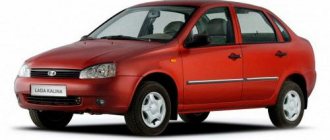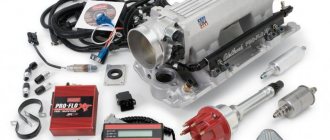Lada Largus 1.6 MT 105 hp
Technical data
The next 1.6-liter is a petrol unit with a power of 105 horsepower. Unlike the previous two engines, in this engine the number of valves has been increased from 8 to 16. This type is installed on both the seven-seat and five-seat Largus. Such a car accelerates to hundreds of kilometers in 13.5 seconds, which is 2 seconds faster than the 87-horsepower one. The maximum speed is 165 km/h, while fuel consumption is 11.5 liters in the urban cycle and 7.5 liters in the suburban cycle. Despite the increased power, fuel consumption has decreased slightly.
Owner reviews
Pavel, Moscow. After the birth of their fourth child in the family, his wife and I decided to take a more spacious car. Since funds were limited, I had to take the Lada Largus 1.6 MT (2014 onwards). In principle, we were satisfied. There is plenty of space in the car. Cons: soft suspension, strong roll when cornering. Average consumption is 9 liters. Boris, Suzdal. I have already driven 14 thousand km and passed the first maintenance. So far there are no complaints. The main advantages are capacity and price. Among the shortcomings, I can name poor sound insulation, driving is not entirely comfortable, although the driver's seat is comfortable, high fuel consumption - 12-13 liters in the city and 9 liters on the highway. Nikolay, Voronezh. Lada (VAZ) Largus 1.6 MT 2013. There are no analogues with seven seats and such spaciousness for such money. The handling is excellent, as is the suspension in general. There have been no breakdowns so far. The only thing that broke was the door handle. Fuel consumption per hundred in the combined cycle remains stable at 9-10 liters. Sergey, Astrakhan. There were already cars before this. Comparing with them, I can say that Largus is a good car. My mileage is about 350-400 km per day, in all the time (I bought a new one in 2013) there have been no serious breakdowns. Consumption is also good - 8-9 liters per hundred in the city, 7 liters on the highway. The only “but” is that it lacks 6th gear and good sound insulation, otherwise everything is fine. Evgeniy, St. Petersburg. I took the car under the recycling program
The first thing I noticed was the low price for such a package. Very practical
The clearance is huge and absorbs all the bumps on the roads. Consumption is about 9 liters. But there are also disadvantages: a bad gearbox - the first gears are a bit short, the low beam is weak.
At the beginning of 2020, sales of Lada Largus Cross started. By its type, the new model belongs to the off-road version. This became possible thanks to the increased clearance between the car and the road. Unlike the standard model, Largus is 25 mm larger. Body kits made of plastic were also added. The new Largus is available only in a luxury configuration and in two modifications: 5- and 7-seater. The cabin is equipped with two airbags, air conditioning and an on-board computer. Under the hood is a 1.6-liter gasoline engine with a power of 105 hp.
Lada Priora
When promoting the Lada Priora to the market, the manufacturer positioned it as a family car with a low cost. This model has been on sale since 2007. Priora has several body styles: sedan, station wagon, hatchback. The latter is produced in two modifications: with five doors and with three.
In 2013, the manufacturer made minor changes to the appearance of this Lada model and made the engines more powerful. The Priora is equipped with one of two petrol power units: either a 1.6 liter engine (the simplest has 8 valves and a power rating of 87 hp, and the most complex has 16 valves and 106 “horses”), or with a volume of 1.8 liters and with a capacity of 123 “horses”.
| Engine | Consumption (city) | Consumption (highway) | Flow (mixed) | Type of fuel |
| 1.6 MT 81 hp (Mechanics) | 9.8 | 5.6 | 7.6 | Petrol |
| 1.6 MT 98 hp (Mechanics) | 9.8 | 5.6 | 7.2 | |
| 1.6 MT 106 hp (Mechanics) | 8.9 | 5.6 | 6.8 | |
| 1.6 AMT 106 hp (robot) | 8.5 | 5.5 | 6.6 | |
| 1.8 MT 123 hp (Mechanics) | 9.8 | 5.6 | 7.2 |
Lada Largus and fuel consumption per 100 km, passport data, real data
Review of Largus Cross
For the Lada Largus, fuel consumption per 100 km according to the passport is 10 liters. And this is an urban cycle, not a mixed cycle or anything else. We're talking about a 16 valve here. So, according to BC data, at first the car consumed 12 liters, and after a week the consumption was 10.5 liters, but this is already a mixed cycle. According to the passport it is 7.9. Question: what's wrong? Maybe VAZ BC is just lying?
Real fuel consumption figures and figures in technical specifications
You need to understand: not a single manufacturer indicates real fuel consumption figures. We are talking about measurements carried out according to a certain method, in order to then use the result to compare cars, different configurations, etc.
Improving your driving style in the first month of running-in
After running-in, fuel consumption on the Lada Largus can be 7 or less than 7 liters per hundred. Here we are talking about highway driving and a 16-valve engine.
The photos shown above are screenshots of the BC display of a real car. We don’t need to falsify the results; besides, these results do not reach the “passport” level.
Passport data on gasoline consumption of a Lada Largus car
For example, consider and compare two tables. One will indicate the fuel consumption of the Lada Largus, the other will show the figures for the Dacia Loan MCV station wagon.
| Station wagon 7/5 seats, 16 cl. (K4M) | 10,1 | 6,7 | 7,9 |
| The same, 8th grade. (11189) | 10,6 | 6,7 | 8,2 |
| Van, 16 cells (K4M) | 10,4 | 6,4 | 7,9 |
| The same, 8th grade. (11189) | 10,6 | 6,7 | 8,2 |
Above are the data from AvtoVAZ, and in the following table are the figures announced by Renault.
| Station wagon 7 seats, 16 cl. (K4M) | 9,8 | 6,3 | 7,5 |
| The same, 8th grade. (K7M) | 10,5 | 6,5 | 8,0 |
Let's analyze what we see:
- Lada Largus and Dacha Logan MCV are the same car. In the version with a 16-valve internal combustion engine, the consumption must be the same, that is, the numbers in the top line of the two tables must coincide. But there are differences here, and noticeable ones.
- None of the tables should be used as a guide during operation. However, the passport data still contains useful information: you can compare different configurations, as well as indicators “for the city” and “for the highway.”
How to use tables? Example 1
A reader asked whether fuel consumption was too high, that is, whether it complied with the standards. For the Lada Largus, fuel consumption standards are not given anywhere, just like for any other car. Now let’s look at how to use passport data:
- Suppose that when driving along the highway, the BC showed a consumption of 7.4 liters. We find our configuration in the table, we see the number 6.7 there. Then there will be a proportion: 6.7 is to 7.4, as 10.1 is to X.
- The number X is 11.2 - this is the consumption rate in the city, but only for this car, for which the readings on the highway were “7.4”.
A car with the parameters that were indicated actually exists. Its mileage is 30,000 km.
Test Largus with K4M engine
Let's use tables again for our own purposes. Example 2
Motor 11189 is more economical than the French K7M. Proof:
- We take any column from the Renault table;
- We normalize the top number to the VAZ numbers: 7.9 is related to 7.5, as 8.2 is related to X.
- X = 8.6. This value would have been obtained if one technique had been used for the K7M engines - the same as for the ICE 11189 and K4M (top table).
The number 8.6 is greater than 8.2. So we compared the two motors. In reality, fuel consumption for the Lada Largus will be different, whether with a VAZ or with a French 8-valve.
About reducing fuel consumption during the running-in process
Find out more about how to reduce fuel consumption on a Lada Largus in the material: how to reduce fuel consumption on a Lada Largus?
Imagine: there is a certain test route on which measurements are taken. As mileage increases, efficiency changes:
- For a mileage of 30,000 km, the figure will be 9.3 liters per 100 km;
- For 60,000 km on the same route, different figures will be obtained - 8.3 liters per 100 km.
Based on these numbers, you can roughly judge when the run-in ends.
All figures given above refer to a real-life car with a K4M engine.
Consumption in the city for a 16-valve Lada Largus, example in video
| Year of issue: | 2012 |
| Body type: | Station wagon |
| Transmission: | mechanical |
| Drive unit: | front |
| Generation: | 1st generation |
| Engine: | gasoline, 1600 cc |
| Fuel consumption on the highway: | 8-13 l/100 km l/100 km |
| Steering wheel: | Left |
| Appearance: | 4 |
| Salon: | 6 |
| Engine: | 8 |
| Ride quality: | 9 |
| Body color: | white |
| Interior color: | black-brown |
Good day to all.
I have long wanted to write my review about the next miracle of the Renault-Nissan concern with the Lada nameplate, but there was no time. I finally gathered my thoughts, poured myself a liter cup of coffee, sat down and wrote. Let me start with the fact that I got the car from the organization. The directors decided to transfer everyone to new budget “foreign cars”. We thought for a long time and chose... And we settled on the Lada Largus. The large barn at the Logan base was just right for our business. We work in the direction of agricultural construction. We took more than 20 cars of various configurations and body options. I got a car in the maximum configuration with a 1.6 liter engine. with a third row of seats, air conditioning, radio, heated seats, etc.
How to reduce fuel consumption of Lada Largus methods, photos, videos
Topic Fuel consumption at idle
When choosing a car, many motorists rely on various technical characteristics. In connection with the latest trends in gasoline prices, motorists want to get a car with ample capabilities, but at the same time with minimal consumption. One of these is Lada Largus. The domestic station wagon, with a Renault engine, gained wide popularity among CIS citizens. But, even though you can refuel 92 instead of 95, some motorists are trying to reduce fuel consumption.
Video about fuel consumption on 92 gasoline of a 16-valve engine:
How to reduce fuel consumption (main methods)
How can you reduce consumption in Largus:
- High-quality tuning.
It will help improve aerodynamic qualities and streamlining. In this case, it is worth understanding that all calculations must be carried out and installed by specialists, and not by “kulibins” of garage tuning. Aerodynamically outlined Lada Largus - Chip tuning will help reduce consumption by up to 15%.
As in the previous case, the operation of updating the on-board computer firmware should be entrusted to professionals. In the process of chip tuning Largus - High-quality gasoline and timely maintenance will help the owner save a little fuel.
- Drive according to traffic rules. On the highway, do not exceed the limit of 100-110 km/h, but in the city there is nothing you can do.
- Well, the most profitable option is to install gas equipment, in particular a propane unit, which will reduce the owner’s wallet consumption on fuel.
Gas cylinder under the bottom, the spare tire will have to be placed in the car interior
All these factors will affect the vehicle’s consumption and will also reduce the cost of fuel and lubricants.
Fuel consumption standard for Lada Largus (certificate consumption)
Often, the factory prescribed fuel consumption characteristics coincide with reality only for the first 30-40 thousand km. Then, everything changes and of course not for the better. So, let's look at the fuel consumption of engines of different configurations:
- The 8-valve engine produces 84 horsepower.
At a speed of 90-100 km/h on the highway, gasoline consumption averages 7.7 liters. But with the city, the difference is significant and the engine “eats” like the old Volga - 12.4 liters. As a result, the combined cycle is 9.5 liters, which is not so little. The 8-valve engine “guzzles gasoline by the bucketful” - A 16-valve engine with a power of 102 horsepower on the highway will have a consumption of 7.5 liters for every hundred kilometers.
The urban cycle is 11.5 liters, and in the end the mixed cycle will be 9.0 liters. The 16-valve valve is no longer so gluttonous, its result is 9 liters per hundred
Thus, it can be seen that the 16-valve engine is much more economical than its smaller 8-valve brother.
What factors affect fuel consumption?
Let's consider the main factors that can affect the fuel consumption of the Lada Largus:
- Technical condition of the car.
- Driving style.
- Tuning.
- Amount of cargo.
- Number of passengers.
- Quality of the road surface.
- Turning on the air conditioner.
- Quality of fuel and oils.
Separately and all together, these factors can cause an increase in the fuel consumption of this car, which is not small.
There are real ways to reduce consumption on the Lada Largus through simple and reliable methods. Another way is to overhaul the engine and install lightweight parts, but the operation is so complicated that not all professionals undertake to do this.
How to reduce fuel consumption
Fuel consumption in any car depends on a number of subjective and objective factors, ranging from traffic congestion, the number of traffic lights along the way and the time of year, to driving style. Driving in an aggressive style will lead to an increase in gasoline consumption standards, and even on a new car, distortions may occur in relation to the data on the Lada Largus passport.
Important! Any unreasonable increase in speed is a sure path to increased gas mileage.
The main factors of increased consumption can be considered:
- The quality of the gasoline being poured is poor; at many gas stations, the octane number is increased using additives, but this does not make the car drive much better, but the gas emissions increase, which leads to high costs.
- All electrical equipment that is turned on while driving takes on part of the generated energy, which can also become a factor in increasing gasoline consumption in a car of any brand.
- In the winter season, a lot of fuel is spent on warming up a cold engine, which naturally increases the consumption of gasoline.
- Worn-out engine parts are one of the main factors in increased fuel consumption. To avoid this situation, you need to monitor the condition of the car and pay attention to the color of the exhaust gases (if the valves are worn out, oil gets into the fuel and the exhaust gases become black and acquire a characteristic odor).
The main advice can be considered the timely identification of problems, and for this you should carefully monitor changes in the performance characteristics of the car. To eliminate one of the common causes of increased gasoline consumption in Lada Largus, you can simply replace or clean the fuel filter.
Let us remind fans that the Lada Largus is a small-format universal “state car”, which was developed by AvtoVAZ with the direct participation of specialists from Renault-Nissan. This is reflected in the appearance of the car, since it is a derivative of the popular modification of the Dacia Logan MCV. The positive aspect of the universal “Russian” is its adaptability to domestic road conditions. This car can please you with its spacious interior, modern body design and spacious luggage compartment. It is these qualities that today form the basis for the priority of a car over the category of practical owners.
You should not ignore such a relevant indicator as gasoline consumption. In the Lada Largus station wagon, this parameter directly depends on the power plant option. Traditionally, driving style also makes a special contribution to the level of consumption.
Car Lada Largus - fuel consumption and other interesting facts
How to reduce fuel consumption on a Chevrolet Niva
Among the many station wagons presented on the Ukrainian automobile market, it is worth paying special attention to the representative of Russian production. This is the Lada Largus, which is a complete visual copy of the French bestseller in this class - Renault Logan MCV. The exterior photos of these two cars differ only in the nameplate on the radiator grille, but the technical characteristics are completely different. If you decide to purchase a Lada Largus, you should take a closer look at all the features of the machine
What kind of car is Lada Largus? We look at the appearance
The Russians decided to leave everything in this station wagon as it was before. We only changed the radiator grill a little and made minor changes to the interior. Now the Lada Largus looks more practical, but this clearly did not give it any visual value. Among the main design features are the following:
loading…
- the rough and straightforward body gives enormous advantages in terms of spaciousness;
- the external perception of a Frenchman with Russian registration is positive;
- the interior has slightly deteriorated the quality of materials;
- Simple wheels in the basic configuration greatly spoil the overall appearance.
The interior looks ascetic; Russian manufacturers have not added any freshness to the Lada Largus. In general, the Russian new product is perceived without much disappointment, but there is also not too much enthusiasm in the reviews of the owners.
Lada Largus: fuel consumption and other characteristics
If AvtoVAZ decided not to work with the design, then they integrated another technology under the hood of the Lada Largus, but also of French origin. The arsenal includes two engines that are already known to us from other models. These are 1.6-liter gasoline power units with 8 and 16 valves that produce 83 and 103 horsepower, respectively. Not enough for such a large car, to be honest. There are no surprises in other characteristics either:
- there is only one gearbox - 5-speed manual;
- acceleration to the coveted “hundred” takes as much as 16 seconds;
- maximum speed – 155 kilometers per hour;
- fuel consumption in the combined cycle reaches 8.5 liters.
Let's be honest, you won't find any special innovations in the technical characteristics of the Lada Largus. Simplicity and practicality are the main advantages of the station wagon.
Prices and configurations in Ukraine
Ukrainian car showrooms present three main versions of the Lada Largus, each of which has about five trim levels. We won’t find any special news in technology, but for comfort there is the necessary set of devices and units. Prices depend on what type of body and interior you prefer:
- a van with two seats and a cargo compartment will cost 9 thousand dollars;
- station wagon with 5 passenger seats – from $10,500;
- A 7-seater starts at $12,000.
The prices are lower than those offered by the French company, so the Lada Largus will definitely find its buyers in Ukraine.
Let's sum it up
Interest in Russian cars in Ukraine has decreased significantly due to the hostile political mood of the two states. Nevertheless, Lada Lragus will definitely find its customers, because such a roomy and practical station wagon for fairly affordable money is no longer available. If you take into account the price features, Largus simply has no competitors.
Owner reviews
“I took the car for work. I really liked the option, because it is not expensive, and there is also a lot of space for both passengers and cargo. The design is very attractive, which is surprising for our cars. I was also surprised by the interior equipment, which boasts many useful functions that allow you to relax on the road. I have never managed to load it to the maximum; there is more than enough space. The engine did not disappoint either. Although there is little power, it drives quite cheerfully, even under high load. And it consumes little fuel, the average consumption is 8 liters,” writes Konstantin from Tula.
This review was left about the Lada Largus by Dmitry from Voronezh:
“I’ve been driving a car for three years now. It's very difficult to find fault with something. The only thing that doesn’t suit me is the poor sound insulation, because of which you can hear the noise of the engine and other sounds from the street. Everything else is top notch. I like the way the interior is made. It seems simple, but there are a lot of functions and everything is right at your fingertips. A very comfortable cabin, which is a pleasure to be in, no matter whether you are a driver or a passenger. Since I work as a courier, it was important for me to have a large amount of free space. Here he is grabbed by the eyes. The engine is rather weak, but I’m not going to race with this car, so it’s enough for me to calmly drive from one end of the city to the other. My gasoline consumption is up to 10 liters.”
“At one time I was building a house on my site. I bought Largus secondhand especially for transporting building materials. Yes, it was possible to take something cheaper and simpler, but it is important for me that I do not strain myself on the road and do not repair the car after each trip. This same model has never let me down. I built the house a few months ago, but I still can’t tear myself away from the car. It looks nice, not as plain as many semi-trucks. I can also say about the salon. I can comfortably transport both a large number of people and cargo. Everything here is made with inexpensive materials, but of high quality. There are also many useful features. One minus is the motor. It is a little weak, especially on the highway, and also has a high consumption, which is 12 liters for me,” says Roman from Tolyatti about his car.
“I never liked our cars, but I needed a large and roomy car that would not be expensive. A friend let me drive his Largus, and I only had pleasant impressions from the car. I bought it without hesitation. There really is a lot of space here. Now I'm transporting various goods to stores and also managing to drop off a few acquaintances along the way. I like the interior, which is made of nice materials. The only disappointment is the sound insulation, which, in fact, is non-existent. You can hear absolutely everything that happens on the street. The engine is quite enough for a quiet ride around the city. I've never been on the highway. The actual consumption of the car is about 12 liters, which is a little more than what is written in the passport,” says Kirill from Novgorod.
“I often travel from one city to another for work. I bought Largus especially for these tasks, since sometimes I have to carry several people with me, as well as a bunch of things. She has no equal here. There's just a wagonload of free space. Even when the car is completely full, no one complains about comfort; everyone is always comfortable and spacious. I’ll note a fairly powerful engine that manages to cheerfully drag it all at a decent speed, consuming only 8 liters on the highway,” writes Vladimir from Orenburg.
“I took Largus for trips out of town, which I make quite often with my family. He can afford to take absolutely any things - everything will fit. Moreover, the seats for passengers will not even be affected. I really like the interior, which is made, although simple, but very functional. The motor also stands out. Possessing little power, it is capable of producing good speed. Its consumption does not exceed 10 liters,” said Peter from Rostov.
Let us remind fans that the Lada Largus is a small-format universal “state car”, which was developed by AvtoVAZ with the direct participation of specialists from Renault-Nissan. This is reflected in the appearance of the car, since it is a derivative of the popular modification of the Dacia Logan MCV. The positive aspect of the universal “Russian” is its adaptability to domestic road conditions. This car can please you with its spacious interior, modern body design and spacious luggage compartment. It is these qualities that today form the basis for the priority of a car over the category of practical owners.
Fuel consumption of Lada Largus 8 and 16 valves per 100 km indicators
The volume of the power unit of the Lada Largus engine, for which AvtoVAZ acquired a license to produce from the French concern Renault back in 2008, is 1.6 liters. In the modification with 8 valves, the power is 84 horsepower. The maximum acceleration speed of this type of engine is 156 kilometers per hour.
In the modification with a seven-seater cabin, the engine characteristics are almost identical, however, it has slightly more power compared to the previous one (by three horsepower).
A line with 16-valve engines is also available; they are installed on both the five- and seven-seater Largus. The acceleration time of such an engine to 100 kilometers per hour is 13.5 seconds, which is 2 seconds faster than the 87-horsepower one. The maximum speed of this modification is 165 kilometers per hour.
Passport data regarding fuel consumption of Lada Largus
As follows from the technical documentation of the model in question, the volume of gasoline consumed on different types of engines according to the passport is somewhat different:
- for an eight-valve engine, the power is 84 hp. With. it is 12.3 liters per 100 kilometers in city driving mode, and 7.5 liters for the same distance when driving on the highway;
- for the same engine the power is 87 hp. With. this figure is 12.4 and 7.7 liters, respectively;
- for a sixteen-valve engine, fuel consumption will be 11.5 and 7.5 liters, respectively, according to the passport.
New model Lada Largus Cross
In 2020, a new type was released in the Lada Largus line. Crosses are classified as SUVs by their type, this is caused by an increase in clearance between the body and the road surface. This car is equipped with a 1.6-liter gasoline engine producing 105 horsepower.
The gasoline consumption indicators of this car correspond to the characteristics of a sixteen-valve engine.
As you know, often passport data does not quite correspond to those that car owners subsequently record during operation. The reasons for this are known to everyone, and it is hardly worth talking about it again and again. However, it is possible, and even necessary, to analyze the reviews of real Lada Largus owners.
Most car owners note a slight excess of fuel consumption over the passport data. So, judging by their reviews on car owner forums on the Internet, for engines with a capacity of 84 horsepower, the actual gasoline consumption when driving around the city is 12.5 liters per 100 kilometers in the city, and when traveling on the highway - 8 liters. On average, the volume of consumption in mixed mode will be about 9.5 liters per 100 kilometers.
The 87-horsepower engines have almost the same performance in both modes; on average, they consume up to 10 liters of fuel per 100 kilometers.
The 105-horsepower engines of the Lada Largus in mixed mode consume 9-10 liters of gasoline per 100 kilometers, when driving around the city - up to 13 liters, and on the highway, judging by the reviews of the owners, the figure ranges from 7 to 9 liters.
Passport consumption indicators of Lada Largus
The Russian station wagon Largus is available with three options of gasoline power units.
The first unit from the Renault-Nissan K7M concern reaches maximum power at 5.5 thousand rpm, and peak torque of 124 Nm occurs already at 3 thousand rpm. The engine is equipped with 4 cylinders and 8 valves. The top speed is 156 km/h, and a hundred is covered in 14 and a half seconds. The rated gasoline consumption is 12.3 liters per 100 km in the city, 7.5 liters when driving on the highway and 9.3 liters in mixed mode.
The VAZ engine gains peak power at 5.1 thousand rpm. The maximum torque of 140 Nm occurs at 3.8 thousand rpm. The number of valves is also 8, and 4 cylinders are arranged in a row. The maximum speed and acceleration time to 100 km/h are equal to those of the K7M. Fuel consumption according to the passport: 10.6/6.7/8.2 l.
The most powerful Largus engine is the 105-horsepower 16-valve Renault K4M unit. The volume is also 1.6 liters, peak thrust occurs when it reaches 5.75 thousand rpm. The maximum torque of 148 Nm is achieved at 3.75 thousand rpm. Maximum speed is 165 km/h, acceleration to hundreds occurs in 13.1 seconds. Gasoline consumption: 10.1/6.7/7.9 liters.
All three units operate on an electronically controlled distributed fuel injection system. When asked what kind of gasoline to fill, the instruction manual states that it is recommended to use gasoline with an octane rating of at least 95. Less powerful engines emit an amount of harmful gases that does not exceed the Euro 5 standard. The 105-horsepower engine fits into the Euro 4 environmental standard.
The gas tank volume for all units is 50 liters.











